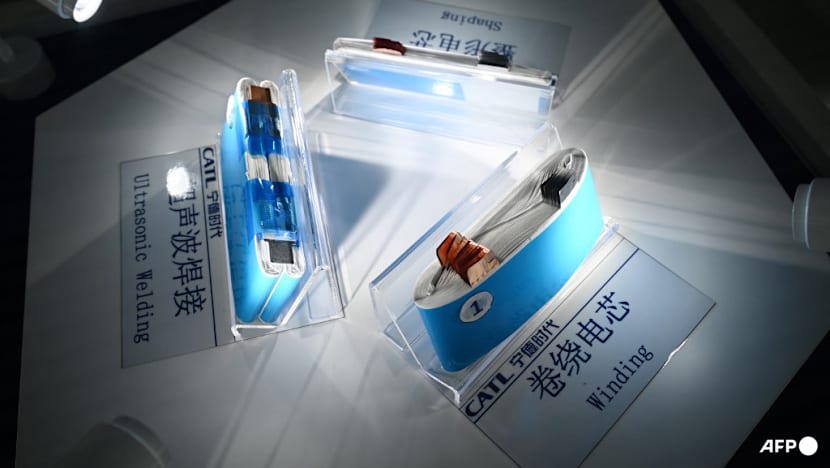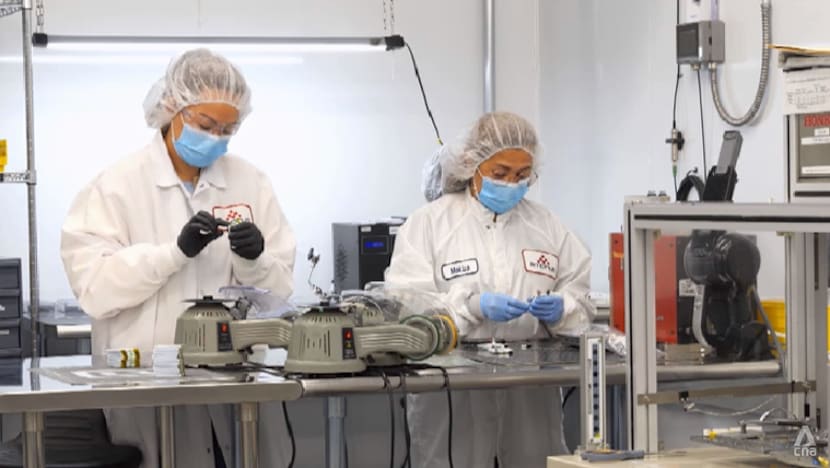China powers ahead in global battery race as US scrambles to catch up
Years of state support have made China the world’s battery powerhouse. Now, American firms are racing to close a decade-long gap in a sector vital to the clean energy transition.

Different stages of the production of lithium-ion battery cells are displayed by Chinese electric vehicle battery maker CATL at a showroom in Ningde, China, on Nov 15, 2024. (Photo: AFP/Greg Baker)

This audio is generated by an AI tool.
FREMONT, California: China has built an almost unassailable lead in the global battery industry, and analysts say the United States now trails by nearly a decade in a sector critical to the world’s clean energy transition.
In the Californian city of Fremont, Amprius Technologies is one of several American companies striving to close that gap.
Engineers in its Silicon Valley headquarters design lithium-ion batteries that use silicon anodes, a lightweight material that can, for example, double the flight time of drones.
The manufacturing firm runs a pilot line at the facility to build and refine new products at a small scale.

At its cell assembly area, where special gear is required to avoid contamination, processes like stacking and electrolyte filling take place.
Stacking is a method of assembling the internal layers of a battery cell, while electrolyte filling is the process of introducing the liquid medium that enables ion transport between these layers.
Still, Amprius Technologies and its fellow US battery makers contribute just a small share of global supply. Much of the world’s battery manufacturing happens abroad, most prominently in China.
CHINA’S SUPPLY CHAIN DOMINANCE
China’s dominance in the battery supply chain is the result of a decades-long push by its government.
Its factories produce over three-quarters of batteries sold globally, at prices about 20 per cent lower than North American manufacturers, according to the International Energy Agency.
The lithium-ion batteries power everything from smartphones and drones to electric vehicles (EVs).
“China is around 10 years ahead of Europe and North America in developing those battery supply chains and EV production,” said Daniel Harrison, an analyst at automotive publisher Ultima Media.
The country’s advantage extends from refining minerals to battery-cell assembly.
China’s grip on the sector has raised alarm in Washington, especially after Beijing introduced new export controls in April this year, restricting seven rare-earth elements, and expanded them further in October to include technologies for mining, processing and magnets.
"They really dominate the supply chain end-to-end,” said Jake Higdon, an energy transition fellow at California Forward, a non-profit organisation which supports the state's economic growth.
“Upstream materials like graphite that go into batteries – that’s dominated by China. Downstream manufacturing, cells, packs, the electric vehicles that the batteries are going into – China is the dominant player on those as well.”
In a tentative deal last month, Washington agreed not to impose its threatened 100 per cent tariffs on Chinese imports, while Beijing committed to hold off on its export restrictions.
RISING US DEMAND FOR CLEAN ENERGY, STORAGE
Even as President Donald Trump’s administration has dialled back support for clean energy initiatives in the US, electric vehicles continue to drive up demand. The need for more renewable energy storage is also heating up.
“Energy storage is becoming more and more important,” said Michael Anderson, the editor-in-chief of the Battery Technology website.
“Grid storage is going to depend on battery storage, not only at the grid level but also at the home level,” he added, referring to batteries connected to power grids that can store energy and then supply it when needed.
Advancements in battery technology mean they are also getting cheaper to produce.
“Costs have come down on an amazing basis,” said Amprius Technologies’ president Tom Stepien.
“It's something like US$100 a kilowatt hour today. Sometimes US$50, sometimes US$150, depending on the actual chemistry. But that number (used to be) 10, maybe even 100 times higher.”
Experts warn that matching China’s scale will require large investments and stronger consumer demand for US-made batteries. Nonetheless, the sector is growing.
“China is the most dominant player,” said Higdon. “But the US still has a couple hundred gigawatt hours of battery capacity, and it has doubled its manufacturing capacity for batteries from 2022 to 2024.”
At the United Nations’ Climate Change Conference (COP30) in Brazil, negotiations are focused on financing and infrastructure for the energy transition. Battery storage technology and grid modernisation are increasingly seen as vital to achieving renewable energy goals.
“I like to think of (batteries) as the point guard of the transition,” Higdon added. “Their job is to make everyone else look good or perform better.”





















